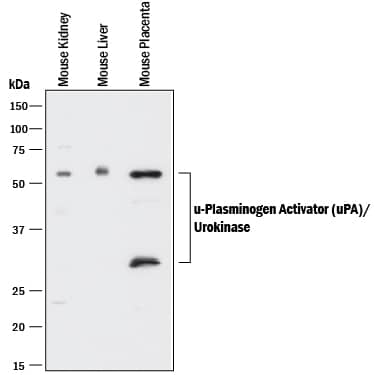Mouse u-Plasminogen Activator (uPA)/Urokinase Antibody
R&D Systems, part of Bio-Techne | Catalog # MAB9185

Key Product Details
Species Reactivity
Validated:
Mouse
Cited:
Human
Applications
Validated:
Immunohistochemistry, Western Blot
Cited:
Western Blot
Label
Unconjugated
Antibody Source
Monoclonal Rat IgG2A Clone # 901420
Product Specifications
Immunogen
Mouse myeloma cell line NS0-derived recombinant mouse uPA
Met1-Phe433
Accession # P06869
Met1-Phe433
Accession # P06869
Specificity
Detects mouse uPA in direct ELISAs and Western blots.
Clonality
Monoclonal
Host
Rat
Isotype
IgG2A
Scientific Data Images for Mouse u-Plasminogen Activator (uPA)/Urokinase Antibody
Detection of u‑Plasminogen Activator (uPA)/Urokinase by Western Blot.
Western blot shows lysates of mouse kidney tissue, mouse liver tissue, and mouse placenta tissue. PVDF membrane was probed with 1 µg/mL of Rat Anti-Mouse u-Plasminogen Activator (uPA)/Urokinase Monoclonal Antibody (Catalog # MAB9185) followed by HRP-conjugated Anti-Rat IgG Secondary Antibody (Catalog # HAF005). A specific band was detected for u-Plasminogen Activator (uPA)/Urokinase at approximately 54 and 30 kDa (as indicated). This experiment was conducted under reducing conditions and using Immunoblot Buffer Group 1.u‑Plasminogen Activator (uPA)/Urokinase in Mouse Kidney.
u-Plasminogen Activator (uPA)/Urokinase was detected in perfusion fixed frozen sections of mouse kidney using Rat Anti-Mouse u-Plasminogen Activator (uPA)/Urokinase Monoclonal Antibody (Catalog # MAB9185) at 25 µg/mL overnight at 4 °C. Tissue was stained using the NorthernLights™ 557-conjugated Anti-Rat IgG Secondary Antibody (red; Catalog # NL013) and counterstained with DAPI (blue). Specific staining was localized to cytoplasm in convoluted tubules. View our protocol for Chromogenic IHC Staining of Frozen Tissue Sections.Applications for Mouse u-Plasminogen Activator (uPA)/Urokinase Antibody
Application
Recommended Usage
Immunohistochemistry
5-25 µg/mL
Sample: Perfusion fixed frozen sections of mouse kidney
Sample: Perfusion fixed frozen sections of mouse kidney
Western Blot
1 µg/mL
Sample: Mouse kidney tissue, mouse liver tissue, and mouse placenta tissue
Sample: Mouse kidney tissue, mouse liver tissue, and mouse placenta tissue
Formulation, Preparation, and Storage
Purification
Protein A or G purified from hybridoma culture supernatant
Reconstitution
Reconstitute at 0.5 mg/mL in sterile PBS. For liquid material, refer to CoA for concentration.
Formulation
Lyophilized from a 0.2 μm filtered solution in PBS with Trehalose. *Small pack size (SP) is supplied either lyophilized or as a 0.2 µm filtered solution in PBS.
Shipping
Lyophilized product is shipped at ambient temperature. Liquid small pack size (-SP) is shipped with polar packs. Upon receipt, store immediately at the temperature recommended below.
Stability & Storage
Use a manual defrost freezer and avoid repeated freeze-thaw cycles.
- 12 months from date of receipt, -20 to -70 °C as supplied.
- 1 month, 2 to 8 °C under sterile conditions after reconstitution.
- 6 months, -20 to -70 °C under sterile conditions after reconstitution.
Background: u-Plasminogen Activator (uPA)/Urokinase
Long Name
Urokinase-type Plasminogen Activator
Alternate Names
PLAU, uPA, uPlasminogen Activator, Urokinase
Gene Symbol
PLAU
UniProt
Additional u-Plasminogen Activator (uPA)/Urokinase Products
- All Products for u-Plasminogen Activator (uPA)/Urokinase
- u-Plasminogen Activator (uPA)/Urokinase Activity Assays
- u-Plasminogen Activator (uPA)/Urokinase cDNA Clones
- u-Plasminogen Activator (uPA)/Urokinase ELISA Kits
- u-Plasminogen Activator (uPA)/Urokinase Lysates
- u-Plasminogen Activator (uPA)/Urokinase Primary Antibodies
- u-Plasminogen Activator (uPA)/Urokinase Proteins and Enzymes
- u-Plasminogen Activator (uPA)/Urokinase Simple Plex
Product Documents for Mouse u-Plasminogen Activator (uPA)/Urokinase Antibody
Product Specific Notices for Mouse u-Plasminogen Activator (uPA)/Urokinase Antibody
Contains <0.1% Sodium Azide, which is not hazardous at this concentration according to GHS classifications. Refer to SDS for additional information and handling instructions.
For research use only
